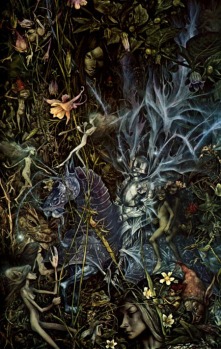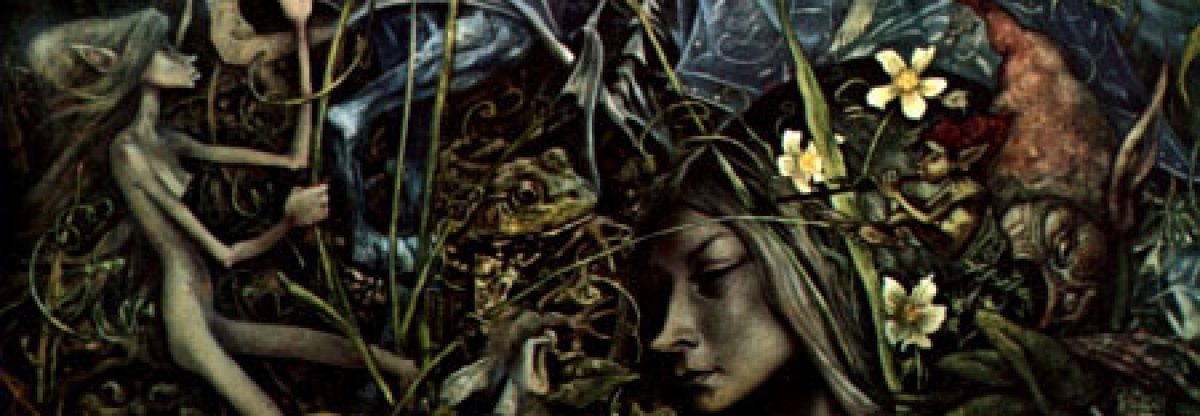Faeries are difficult to portray through the medium of film and documentary. They are too amorphous and difficult to pin down – a bit like in real life. They’re happier living in the consciousness of humans than being captured on celluloid. But some have tried, and so whilst not pretending to be an exhaustive list of filmic faeries, I thought I’d put together a list of some of my favourites, both dramatic and documentary. I hope you might find something new here, with all links embedded…

Photographing Fairies is a 1997 film directed by Nick Willing, based on the book by Steve Szilagyi. It’s also absolutely bloody marvellous. The plot (without spoilers) revolves around a photographer, Charles Castle (played by Toby Stephens) who is beset by grief and guilt after his new wife is killed in an Alpine accident just before the First World War. Hardened against any type of religion or spirituality, he returns from the trenches to his photography business in London. When a woman turns up at his studio with a photo of her daughter with a faerie, he becomes obsessed to find out the truth behind it, taking him on a journey right down the rabbit hole.
The main plot device rests on the faeries becoming manifest during altered states of consciousness, brought about by the consumption of a small white flower. This alters the perception of time and allows interaction with the faeries, who exist as luminous humanoids. The scene when Castle first takes one of the flowers is a cinematographic treat; unsettling, trippy, beautiful and moving all at the same time. He never manages to photograph the faeries, but he does come to the realisation that they are arbiters between the material world and transcendence from this world. In the words of Arthur Conan Doyle (who makes an appearance in the film) they are the handmaidens of the eternal.

Also made in 1997, but less dark and hallucinogenic, is Fairytale: a true story, directed by Charles Sturridge. It’s loosely based on the story of the Cottingley faeries, and is viewed from the perspective of the two little girls, Elsie and Polly, who discover and photograph the faeries living in the backwoods of their Yorkshire home during the First World War. The premise is that you have to believe in the faeries to see them, and that this is much more likely to happen if you’re a child. It’s pretty sentimental, but the faerie scenes are well executed, and there is a stellar cast, including Harvey Keitel as Houdini (yes, that Houdini) and Peter O’Toole as Arthur Conan Doyle. The final scene when the whole tribe of winged faeries turn up at the girls’ house (initially seen from the faeries’ perspective) is joyous and magical.

A different approach is taken in Kirk, a 2009 film by the (then) teenage director Michael Ferns. It won the Best Independent Feature Film at the Manchester Festival of Fantastic Films and is reviewed in depth by MJ Simpson here. It’s set in the Scottish Highlands in the late 17th century, and tells the story of the Reverend Robert Kirk, who wrote The Secret Commonwealth of Elves, Fauns and Fairies (see The Secret Commonwealth for my take on the story). It takes a reductionist view of the story, where Kirk’s belief in faeries is wholly instigated by the parish femme fatale, Mary, who lures the married vicar with sweet talk of the faerie folk, much to the chagrin of his wife Abigail. Kirk’s acceptance of the faeries is made to seem delusional, but there is enough ambiguity to keep us wondering about what’s really going on, heightened by the subdued lighting and colour, which lends an ethereal tone to each scene. The faeries themselves never show up, but there are luminous dream sequences where Mary takes the part of the alluring faerie queen, intent on ravishing Kirk. If you know the story, you’ll know it ends badly, and if you have half a heart you’ll be wiping away a tear after a beautifully told tale with sensitive acting and a dynamic screenplay.

Bringing us up to the 21st century are two documentaries that investigate the belief in faeries in Iceland. Huldufólk 102 (Hidden People) is a 2006 film, atmospherically underscored by indigenous musical luminaries Sigur Rós, Amina and Múm. One of the talking heads, historian Magnus Skarphedinsson, sets the tone right from the start when he states: ‘There is no doubt in my mind that there are two nations living in this country; the Icelandic nation and the invisible nation.’ This concept is maintained throughout the documentary, which films Icelanders from a range of backgrounds talking about the hidden folk and how they are an intrinsic part of Icelandic culture. It’s an excellent insight into how modern belief in the faeries pervades the society, and affects everyday life, from where to build roads (always avoiding the rock homes of the Huldufólk) through to the faeries incorporation into Christianity. Star of the show is the grizzled and wizened farmer þórleifur Hjalfason, who tells a story about the hidden folk burnishing and sharpening his knife – a common faerie-helper motif in folklore, made real at his remote Icelandic farm.
A bit more out there is the 2002 documentary Elves, Ghosts, Sea Monsters & ETs In Iceland – Investigation Into The Invisible World, which spreads a wide net over Icelanders’ belief in otherworldy beings in their landscape, mostly through the eyes of clairvoyants, who use their psychic abilities to shed light on the faeries and their customs. It’s a beautifully evocative piece of film-making, that brings out the mesmerising strangeness of the Icelandic environment, and presents a modern faerie belief that is deeply embedded and alive in the culture.

John Walker’s 2000 documentary The Fairy Faith takes a trip around the UK, Ireland and Cape Breton Island, Canada, to interview people who have had experiences with faeries. The photography is sumptuous and Walker uses Celtic music to draw us into a world where things are not quite as they seem. His narration is sensitive to the beliefs of the people interviewed and we are left with the impression that the faeries are just an inter-dimensional breath away. Highlights include Brian Froud talking about his fantastic faerie artwork, and Eddie Lenihan, the magnificently whiskered Irish storyteller, who tells it like it is (his website can be found here).
When Walker reaches Cape Breton Island in Nova Scotia, he goes with Marie-Rose and her daughter April, to a forest river to hear about their faerie encounter several years previously. It’s quite clear that they are authentic, and genuinely recalling the experience as best they can. The encounter consisted mostly of hearing music and singing — Marie-Rose was evidently afraid of the phenomenon and dragged her children away from the river and into the car to get away. As they drove away, April watched out the back window as a group of small faeries were: “jumping around in a circle, holding hands. They were singing… and dancing in a circle. They sort of mixed right in with the background, and I don’t know whether they were see-through or what.” For my take on the faerie circle dance see Going Round in Circles: The Faerie Dance.

The Fairy Trail: A Documentary about Nature Spirits is a 2013 film by Till Gerhard and Britta Schmidtke. It takes a decidedly hippy turn, and looks at the faerie phenomenon from a Steineresque angle, with the emphasis on the faeries as nature spirits, interacting with people and the environment. Eddie Lenihan pops up again, but much time is spent at the Findhorn community in Scotland, where the relationship between the people and the nature spirits is an essential concomitant to the success of this unique place. There are several interviews with Dorothy MacClean, one of the original founders of the community in the early 1960s, whose matter of fact descriptions of working with the faeries is fascinating and convincing. The other interviewees are mystics, clairvoyants, environmentalists and witchy sorts, who help us get to the deeper meaning of our connection to the natural world, and the non-material elementals who are always there helping out, for those with the ability to sense them. Marko Pogacnik has a particularly interesting take on working with nature spirits, which includes earth acupuncture based on the hypothesis that this is what our prehistoric ancestors were doing with some of their stone monuments.

Shakespeare’s A Midsummer Night’s Dream faeries are given a full-on luvvy treatment in Michael Hoffman’s big-budget version from 1999. It’s lavish and true to script, but you get the impression that it was all just a jolly so the stars could spend some time in Tuscany. Here’s an excerpt from the New York Times review:
Michael Hoffman’s fussy production of “A Midsummer Night’s Dream” is just such a parade of incongruities, with performances ranging from the sublime to the you-know-what. Hoffman has transported the play’s humans and fairies to Tuscany, where they switch partners under the influence of trickery from Stanley Tucci’s mischievous Puck.
But there’s no magic potion to banish the film’s awkwardness or make it more than a string of intermittent acting highlights. Puck’s “Lord, what fools these mortals be!” looks like an understatement under the circumstances.
There are some other film versions, notably from 1935 and 1996, but perhaps the wackiest version is from 1968, where participants seem to have got into the spirit of the times by partaking of certain psychoactive substances before filming. It’s wild… and Judi Dench appears naked and painted green. If you dare, you can watch it here.

And finally… There may be plenty of cartoon faeries on film, but I’m skipping Tinkerbell and her Disney friends (and definitely passing over Barbie: A Fairy Secret… apparently, Ken gets kidnapped) in favour of this corker from 1981. Faeries tells the story of a medieval mortal (named after the Irish folk hero Oisín) abducted to faerieland in order to help the good faeries see off the goblins, bogeys and hags, who have been causing trouble in the otherworld. The faeries are based on the illustrations of Brian Froud and Alan Lee from their classic book of the same name, and much attention to detail is paid to genuine faerie lore and folklore motifs, such as the hollow hills and the faeries’ circle dance. It’s made for children, but made by adults who have allowed psychedelic mushrooms to be part of their lives. It’s a must view.
***
Addenda February 2017… The Faeries of Blackheath Woods I came across this short faerie film recently. It gives us an alarming visual description of faerie vindictiveness… one of their common folkloric traits.
For the films I’ve missed, you might want to take a look at the list of faerie films on the Fairy Investigation Society’s website here.
Elficología en España also has a You Tube site with some top faerie videos – check it out here.


Reblogged this on Kate McClelland.
LikeLiked by 1 person
Thank you Kate… always appreciated…
LikeLiked by 1 person
Reblogged this on firefly465.
LikeLiked by 1 person
Many thanks…
LikeLike
I would love to see Kirk (2009) but it is nowhere to be found?
LikeLiked by 1 person
You’re right – it was never released on DVD and is nowhere to be found streaming. I was lucky enough to see it at an arts cinema in Manchester when it was part of a festival. It’s a lovely film, and hopefully one day it’ll be released as a cult classic.
LikeLike